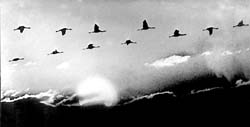Arguments over springtime hunting never cease

Last spring Ukrainian hunting law allowed — after a 77-year break — the springtime shooting of waterfowl. Although the hunting item has already been incorporated into the law, permission to hunt has not yet been signed this year, for the Ministry of Ecology is deluged with letters from angry conservation organizations. The ministry in turn has sent a query to the regional departments, which usually answer in the negative: “a feasibility study is required to allow shooting,” it is impossible to identify the migratory rate in the regions (the number of feathered individuals crossing the regional borders) due to the absence of methods of accounting, etc., says Volodymyr Tarasenko, chief of the Department for the Protection of Wildlife and Flora of the Ministry of Ecology. Hunters, of course, see the problem differently. In this connection, the Green File environmental organization suggested last week that both sides hold a press-club-type meeting to discuss the conflicting arguments.
“During migration, about 200,000 European winter geese, almost 85% of the total population, cross the territory of Ukraine. Out of the five species of geese that migrate across Ukraine, two are rapidly falling in number,” noted Anatoly Poluda, director of the Ukrainian Bird Banding Center. In the spring, the number of birds is about 30-40% of the summer figure, the latter rising in the wake of breeding. Thus it is unwise to reduce the population in already depressed conditions, for the quarry are exhausted after their migratory flight, and there is also the risk that their number will not be restored after the hunting. In addition, Green File members claim that the nestling geese pair off well before breeding season — if one of the partners dies in spring, the other one cannot find a mate that season. Gunshots scare the birds: they suspend their mating rituals and fly away in search of a quieter place. And, in general, a gaunt spring goose does not look like much of a trophy, the center director says.
A member of Bird Life International, Ukraine has ratified several international covenants, including the Bern Convention on the Conservation of European Wildlife and Natural Habitats and the Bonn Convention on the Conservation of Migratory Species of Wild Animals. Accordingly, the commitments undertaken must be fulfilled, says Oleh Dudkin, coordinator of conservation projects at the Ukrainian Bird Protection Society. The population of one wild goose species — the lesser white-breasted goose (Anser erythropus) — in Ukraine is 500 individuals at most, while hunting is one of the seven major threats to wildlife, according to a study under the auspices of the Convention on Biodiversity. While the geese are on our territory, they suffer greatly in any case from poachers and villagers who with sticks in hand protect their fields from being eaten by the birds (for example, a mass killing of birds occurred last year in Kherson oblast over damaged winter crops). Moreover, the rare and common species of geese often fly in the same skein, and it is extremely difficult for a shooter to tell a rarity from the run-of-the-mill.
“The principal argument of conservationists is that shooting is allowed for as long as six months, so hunters have enough time. But they often forget that it is allowed to hunt only on certain days of this period, for example, only on Saturdays and Sundays in the summer and fall. In Germany, the phrase Sunday hunter sounds disparaging, while here the law demands it,” says Yury Yanysh, senior research associate at the Institute of Oncology, who has been hunting for 30 years. Spring shooting is a very troublesome thing, one begins to get ready for it way back in the fall. Moreover, far from every 265,000 licensed hunter actually takes part in the sport. Thus it is wrong, he believes, to say under such conditions that hunting is an endangering factor: incidentally, the number of the jackrabbits killed by automobiles or of birds poisoned by pesticides equals the number bagged by sportsmen. According to Ihor Khlivetsky, editor of Myslyvets (Hunter) magazine, legal hunting prevents poaching and is subject to strict rules: for instance, you must not shoot the birds swimming on the water surface, you can only shoot a certain number of game birds per hunt, which must be recorded on a special accounting card (incidentally, in the absence of the latter, one will not get the hunting license even if he enjoys the legal status of hunter). Plus, if we are to refer to European experience, it is allowed in many countries to shoot the mentioned white-breasted goose, they note. Moreover, the experts think that shooting helps make rational use of the population resources. For example, banning springtime shooting in the US brought about a three-to-one ratio of females and males in one of the goose species, while the collapse of many hunting estates in this country resulted in an increased incidence of rabies among foxes.






